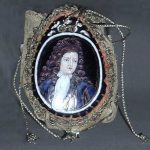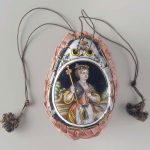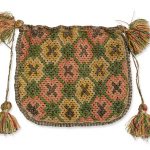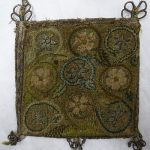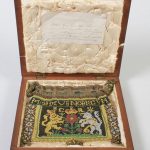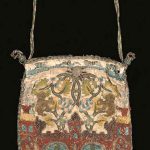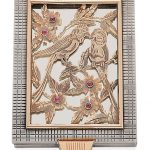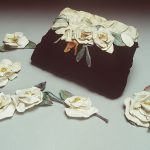Many decorative early 17th century bags survive, but it is not entirely certain how they were used and worn. They are too delicate and elaborate to serve as receptacles for money carried on one’s person on a daily basis. Few commercial exchanges in the early 17th century required cash, and most household shopping was done by servants. However, they were used as a form of gift-wrapping for the presents of coin that were offered as a New Year’s gifts to the monarch. Reference: Victoria and Albert Museum
Bag last quarter 17th century French
By the seventeenth century, gift-giving had become an elaborate ritual among the upper classes. Monetary gifts were often presented in small decorative purses made from costly materials. Gift purses such as this enameled drawstring bag were a specialty of the French town of Limoges
p>Reference: The Metropolitan Museum of ArtDrawstring bag French late 17th–early 18th century Object Place: France
Drawstring bag. Rose-pink silk taffeta with 2 enameled metal plaques (one with man, other with woman, both carrying staffs in vaguely late 17th-early 18th century costume) edged with pleated silk ruffle. Yellow metallic cord drawstring.
Reference: Museum of Fine Arts Boston
AN ENGLISH OR FRENCH NEEDLEWORK DRAWSTRING PURSE OR SWEET BAG, 17TH CENTURY worked in rococo stitch with silk and metal thread, unique patterns to both sides; with a brass display stand on a black-velvet covered base and Perspex case Height 3 1/2 in. by Width 4 1/4 in.; 8.9 by 10.8 cm.
This purse, or sweet bag, is unique in its use of two different patterns on the front and back and also in its unusual form. Most English purses of the 17th century are created as squares with a tassel drawstring closure and three tassels hanging on the base. This example is reminiscent of the shield form with its braid border and lack of bottom tassels, but is slightly more square than traditional shield shapes and does incorporate a tassel drawstring.
Sold for 2,250 USD at Sotheby’s in 2019
A flat, square bag of linen worked in tect stitch with silver thread ground and coloured silk scrolls, flowers and leaves. The bag was once lined in coral-pink silk and once had a drawstring.
1600-1650 (made)
Reference: © Victoria and Albert Museum
A 17th century beadwork purse With a beadwork English Royal coat of arms depicting a lion and unicorn, with a drawstring closure, in a padded wooden box, with a hand written note attached to the inside lid.
Sold for £ 8,400 inc. premium at Bonham’s in 2007
A SILK PURSE, 17TH CENTURY worked in coloured silks to a white ground, depicting a red brick bridge over flowing water, with squirrels above, English,–5in. square, (12.7cm)
Sold for GBP 1,320 at Christie’s in 2007
